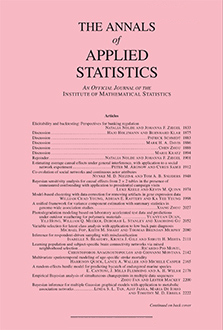Abstract
ANOVA decompositions are a standard method for describing and estimating heterogeneity among the means of a response variable across levels of multiple categorical factors. In such a decomposition, the complete set of main effects and interaction terms can be viewed as a collection of vectors, matrices and arrays that share various index sets defined by the factor levels. For many types of categorical factors, it is plausible that an ANOVA decomposition exhibits some consistency across orders of effects, in that the levels of a factor that have similar main-effect coefficients may also have similar coefficients in higher-order interaction terms. In such a case, estimation of the higher-order interactions should be improved by borrowing information from the main effects and lower-order interactions. To take advantage of such patterns, this article introduces a class of hierarchical prior distributions for collections of interaction arrays that can adapt to the presence of such interactions. These prior distributions are based on a type of array-variate normal distribution, for which a covariance matrix for each factor is estimated. This prior is able to adapt to potential similarities among the levels of a factor, and incorporate any such information into the estimation of the effects in which the factor appears. In the presence of such similarities, this prior is able to borrow information from well-estimated main effects and lower-order interactions to assist in the estimation of higher-order terms for which data information is limited.
Citation
Alexander Volfovsky. Peter D. Hoff. "Hierarchical array priors for ANOVA decompositions of cross-classified data." Ann. Appl. Stat. 8 (1) 19 - 47, March 2014. https://doi.org/10.1214/13-AOAS685
Information





